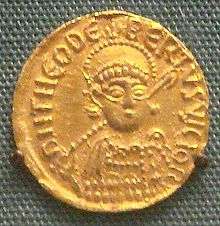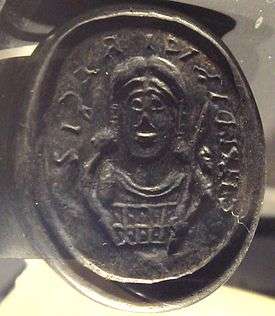Sigebert III
| Sigebert III | |
|---|---|
| King of Austrasia | |
|
Sculpture of Sigebert in France | |
| Wife | Queen Chimnechild of Burgundy[1] |
|
Issue | |
| Father | Dagobert I |
| Mother | Ragnétrude[2] |
Sigebert III (c. 630–656/660) was the king of Austrasia from 634 to his death; around 656–660.
He has been described as the first roi fainéant—do-nothing king—of the Merovingian dynasty.[3]
Family
Sigebert was the eldest son of King Dagobert I and his concubine Ragnetrude and half-brother of King Clovis II.[4]
His wife was Queen Chimnechild of Burgundy and their son was King Dagobert II.
His granddaughters were said to be saints Adela and Irmina, but this has been largely rejected.[5]
To satisfy the Austrasian aristocracy (who exercised a certain autonomy), Sigebert's father gave him the kingdom of Austrasia, although it remained part of the larger Frankish realm.
Biography
On the death of his father, Sigebert ruled Austrasia independently and free from any subjection to Neustria. Under the tutelage of Pepin of Landen and other saints of the time, the young king grew into pious adulthood.

He tried in vain to add Thuringia to his kingdom, but was defeated by Duke Radulph in 640. Though only ten years of age, he was the leader of his army. The Chronicle of Fredegar records that the rout left him weeping in his saddle. The downfall of the Merovingian dynasty was a result of child rule, for both Sigebert and his younger half-brother, who ruled in Neustria, were prepubescent children who could not fight on the field and whose regents had their own interests at heart.
It was under his reign that the Mayor of the Palace began to play the most important role in the political life of Austrasia. Mayor Grimoald, the son of Pepin, managed to convince the king to adopt his son Childebert. When Sigebert finally had a son of his own, the future Dagobert II, the mayor felt threatened, and on the death of Sigebert (at the age of 25) he exiled the young Dagobert to Ireland. Sigebert's remains, defiled during the French Revolution, are preserved in the cathedral at Nancy.
Though not a success as a king, he was revered as the founder of numerous monasteries, hospitals, and churches. He is regarded as a saint by the Catholic Church and is the patron saint of Nancy.[6]
Sources
- R. P. Vincent, Histoire fidelle de st Sigisbert: XII roy d'Austrasie et III du nom; avec un abrégé de la vie du roy Dagobert, son fils: le tout tiré des antiquités austrasiennes
References
- ↑ The Construction of Communities in the Early Middle Ages: Texts, Resources... by Richard Corradini, Max Diesenberger, Helmut Reimitz
- ↑ A Rib from Eve by Katherine Christensen
- ↑ Jean Verseuil, Les rois fainéants: Dagobert and Pépin, Paris, 1946 (ISBN 978-2-7413-0136-3).
- ↑ Fredegar IV, 58: Nantechildem unam ex puellis de menisterio matrimonium accipiens reginam sublimavit.
- ↑ Vita Sancti Wilfrithi ("Life of St. Wilfrid")
- ↑ Saint Sigebert III of Austrasia
| Sigebert III Born: 630 Died: 7th century | ||
| Preceded by Dagobert I |
King of Austrasia 634–656/660 |
Succeeded by Childebert the Adopted |
| Wikimedia Commons has media related to Sigebert III. |


